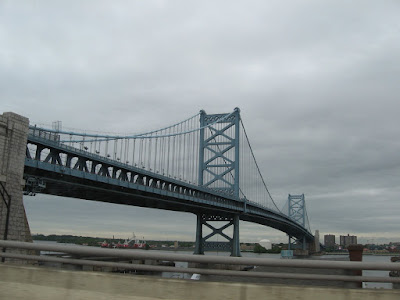
We pass through a couple of quaint towns, Fredricksburg, Virginia is one that comes to mind. These places at least look pretty enough, although it all seems a bit new and film set-ish and commonly deserted.
The state of Virginia is famous for it's tobacco plantations and at the time of independence was the richest of all the American colonies. George Washington, America's first president and general of the victorious army fighting the Brits, was a wealthy land owner from Virginia so you could say the roots of the U.S.A started to grow from this state.

We haven't travelled far but things around us have changed somewhat. The roads are flanked by
thick vegetation and the temperature has shot up. It's a weird thing to know that only a couple of days ago we were soaked and cold in Washington D.C. to now getting out of the car with a t-shirt on.
We arrive in Williamsburg at a cheap motel with an outdoor pool and holiday makers sunning themselves. Williamsburg is a year round destination, and not due to the weather. The attraction is Colonial Williamsburg which is a reconstructed settlement on the site of one of the early American colonies. Thousands flock to this town of white picket fences and well dressed colonial properties to get a taste of the life that the early settlers had.

Colonial Williamsburg is connected to two other nearby settlements, Yorktown and Jamestown, that also have some reconstructed buildings and plenty of information about early life here, including the Native Americans that inhabited the place originally. We decide to visit all three just because we can.
We stroll along a bridge from the car park to a large visitors centre that has prices up for various tickets of entry. I remembered reading a Bill Bryson book about this place so I was pretty confident that you didn't actually have to pay to have a look round, they just make it seem like you do. It turns out to be free but the limitations to that are missing out on seeing some re-enactments and entrance to some buildings. Oh, and you don't get to ride on the bus that takes you the 500 yards from the visitor's centre to the town itself. Big deal. I think for £25 a ticket I'll be quite happy with just having a nosey around.

The main street is a pleasant dusty road with pristine buildings dotted along either side. At one end of the village is a paved area of shops for people to fulfil their need of entering a shop every time they leave the house.
Everything is about the revolution here and the 'tyrannical' British rule. Seriously, if they thought we were tyrants I'd hate to imagine what they'd thought if the Russians or Chinese had control in those days.
For all it's fakeness and 'too clean' appearance I can't help but like it around here. The sun is blazing, lush green foliage and picture perfect houses and grounds are around every corner. It's not really somewhere you'd want to live but it's a pleasant place to visit.

We leave the period costumed Americans on horseback or at the reigns of a horse drawn carriage to visit nearby Yorktown for tea. We cook pasta, like the poverty stricken travellers we are, by the water looking over at a decent bridge as the sun goes down.
 Yorktown is basically just a short street with a few colonial properties but it does have more of a traditional British feel than Williamsburg. The real visiting spot here is all the battlefields around town that you can visit but for me they all look achingly dull.
Yorktown is basically just a short street with a few colonial properties but it does have more of a traditional British feel than Williamsburg. The real visiting spot here is all the battlefields around town that you can visit but for me they all look achingly dull.Next morning we drive the connecting road of these three towns, the Colonial Parkway, to visit Jamestown. Later that evening we read about the Colonial Parkway murderer who had been killing unsuspecting couples along this uninterrupted route and still was yet to be caught, ah well.
I was expecting a town in Jamestown but non such thing exists. Just foundations and a chapel remain and a load of information about the early settlers. This was in fact the first successful British settlement on the continent. Town decisions were being made here a year before the pilgrims landed at Plymouth Rock. So Plymouth not only wasn't the first settlement it wasn't the first landing point either so how it gained fame I've no idea.
Jamestown ended in failure eventually anyway. A couple of fires ravaged the settlement and those who didn't starve to death through lack of farming knowledge managed to move on. The local natives helped out the settlers and showed what was mainly a clerical population how to grow crops and when and where to plant. This help from the natives is where the American holiday of Thanksgiving comes from after the celebration of a successful harvest. Once the natives had helped the settlers and they could survive without assistance they killed or ran out the Native Americans. Yeehaw!

This settlement by the river eventually became another tobacco plantation after it burned for the last time. It's a humid place and I get the feeling that it's only going to get hotter for the final month of our trip.














